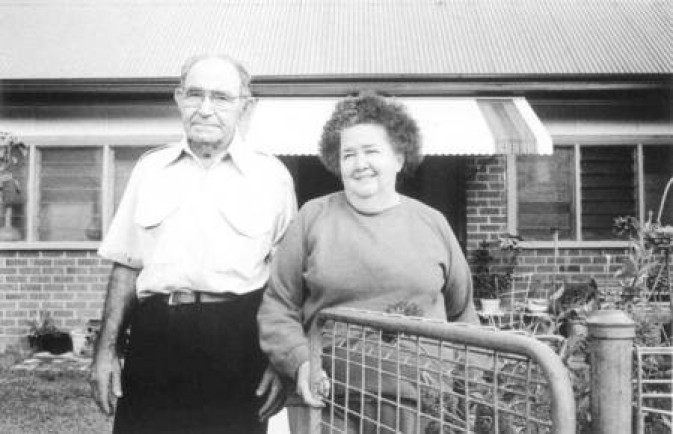Xenophon Stathis with his wife Patricia (nee, Fleming), Wagga Wagga, NSW, 1989.
Xenophon was born in Karvounathes, Kythera, in 1914. He came out to Australia in 1928 as part of a group of nine young Kytherian boys sent to work in Greek cafes.
[You can see a photograph of Xenophon with five of the other young boys on their embarkation from Kythera on kythera-family by searching under Xenofon on the internal search engine. The entry etitled A journey for a better Life was submitted by a son of one of the "boy men", Arthur Sklavos.]
Immediately after arriving in Sydney he journeyed by rail to Wagga Wagga, and commenced work at the Popular Cafe. Its proprietors were Spiros and Stamatina Psaltis.
'I had a tag on my coat here (pointing to his chest) - "Put him out at Wagga"...I was a very luck boy, I come to a place, I never knew a soul...they took me in as their own son...they didn't have any family themselves...I was with them from the day I come to Wagga till they died, except nearly six years when I was in the army. That's the only time I was away from them...I went to enlist...in the hope to see my parents.
Unfortunately, I wasn't naturalised at that time. It was 1939...Not long after that it was in the newspaper that I was naturalised ....So a fortnight later I was conscripted...That bit of paper, naturalisation...it never changed me...I took it (not being accepted for army service without first being naturalised) a bit hard because I was still the same person...(I went) to the islands in the Pacific...was at New Guinea...I came back to Australia on the hospital boat...I finished up (as a) sergeant.'
Xenophon was discharged on 26 June, 1946. He then returned to Wagga Wagga and took over the Popular Cafe from the Psaltis's.
Ten years later Xenophon married Patricia whom he describes as a 'third-generation Australian'. The ceremony was conducted by a Greek priest who was brought in from Sydney for the occasion in Wagga Wagga's local Anglican church. The couple have two sons, Peter and Spiros.
In 1968, Xenophon sold the cafe business. His only trip back to Greece was in 1986. 'I went with my wife and Spiros...You know, I did like to go and see me sisters. But apart from that, I didn't like it - because the home I was born, there's nothing there'.
Reflecting on being a Greek-Australian Xenophon recalls: 'Australian fella (said to me once)..."Doný worry boy" he says, "You're one of us now". He says, "We accept you as one of us". Well that hurts, doesn't it. He says "We accept you as one of us". Well what the hell am I? In other words he still looks at me as wog, doesn't he? Well that hurts'.
From, Images of Home, p. 156-157.
*There are about 33 other Kytherian images and entries in the book, Images of Home.
Author's:Effy Alexakis & Leonard Janiszewski
When Published:1995
Publisher:Hale & Iremonger Publishers
Available:Hale & Iremonger Publishers, 02 9565 1955
Description:285x210mm, 160 pages.
Available from:
Hale & Iremonger
PO Box 205,
Alexandria, NSW. 2015.
Ph: 02 9656 2955
Fax: 02 9550 2012
Eml: frontdesk@haleiremonger.com
Website: www.haleiremonger.com
Documentary photographer Effy Alexakis and social historian Leonard Janiszewski have been researching their history and contemporary presence since 1982, and have made many field trips throughout both Australia and Greece, painstakingly piecing together what has become a giant jigsaw puzzle.
Effy Alexakis:
"The idea for this project began in Greece in 1985 whilst I was staying with the parents of family friends in the village of Mitata, on the island of Kythera. Although I had already noticed many deserted homes throughout Greece, it wasn't until I saw a whole street of deserted homes and ventured inside them that I realised that many of the people had left their homes with the intention of returning. Letters, photographs and other personal documents had been left behind. Like pieces of a huge jigsaw puzzle, these items provided small clues about the life within these homes. Australia's migration history is to be found in these homes. Unfortunately, through time, much is being lost."
For a digital archive of photographs, see, also,
http://www.austhistmuseum.mq.edu.au/greek/intro.htm
For other entries about Effy and Leonard, search internally, under Alexakis or Janiszewski.
